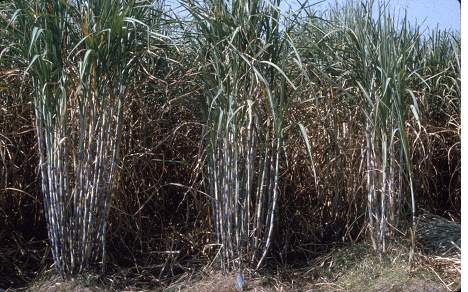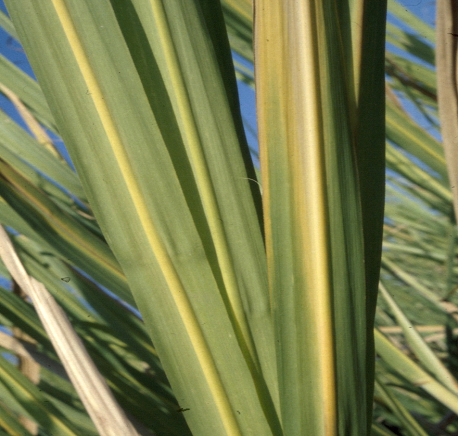Sugarcane Disease Detection Lab
Sugarcane is a very traditional and economically important crop in Louisiana. The crop is vegetatively propagated by planting stalk sections containing buds (seed cane) rather than true seed. Sugarcane is adversely affected by a complex of diseases caused by pathogenic bacteria, fungi, and viruses. Some of our most important diseases are caused by pathogens that are systemic, that is they are distributed throughout the plant. This means that systemic pathogens will be present in stalks of infected plants and can be spread and increased during the planting process. As a result, planting healthy seed cane is an important method for minimizing losses due to systemic diseases.
The healthy seed cane program for the Louisiana sugarcane industry is now based mostly on the planting of seed cane produced through a laboratory process known as tissue culture. A key component of the program is disease monitoring. Two of the systemic diseases, ratoon stunt and yellow leaf, do not show visible external symptoms of disease. Therefore, lab testing is needed to determine whether ratoon stunt or yellow leaf is present in a given field. Disease detection methods have been developed and adapted for use in the LSU AgCenter Sugarcane Disease Detection Lab (SDDL) for both diseases, and this testing service is available to Louisiana sugarcane industry representatives, including direct testing for farmers.
Ratoon stunt disease (RSD) is caused by a microorganism that lives in the water vessels (xylem) in the sugarcane plant. The bacteria that cause RSD increase in the stalk during the season. They can produce a gel-like material that can plug the vessels. This can result in stunted growth of the stalks. The stunting will be worse under drought conditions and gets worse in the ratoon or stubble crops. RSD is spread mechanically in infected sap from plant to plant during harvest or in seed cane from one field to another. There are no visible external symptoms of disease other than reduced growth, so the only way to know if RSD is present is by a lab test. The sap from the water vessels must be tested for the bacteria. Planting of seed cane produced through tissue culture and monitoring of RSD has reduced disease incidence to a low level in the industry. However, it can persist on farms without the farmer realizing it is present. RSD testing will ensure that RSD is not hurting yields, and that money invested in a healthy seed cane program is providing the expected benefit.
Yellow leaf disease (YLD) is caused by a virus found in the vessels (phloem) in the plant that transport food produced in the leaves to other plant tissues. This virus is transmitted from plant to plant by aphids. The characteristic symptom of the disease is a bright yellow midvein in young leaves on mature stalks. This symptom usually does not develop until the cane is 10-12 months old. However, with the short growing season in Louisiana, symptoms cannot be seen due to ripener application or frost damage. The disease can reduce yields in susceptible varieties, so lab testing is used to ensure that seed cane produced through tissue culture contains little or no YLD. YLD testing is conducted as part of the Seedcane Certification Program under the supervision of the Louisiana Department of Agriculture and Forestry. Every field must be tested and found to contain little or no YLD to be certified for sale to farmers. The release of resistant cultivars and the adoption of clean seed cane by farmers in Louisiana have kept the incidence of YLD and RSD at low levels for many seasons in our state. However, as those two systemic diseases cannot be diagnosed through visual symptoms, we highly recommend that growers take advantage of our seed cane testing at LSU AgCenter. All samples are processed with no cost to growers. The American Sugar Cane League sponsors this diagnostic service. The SDDL uses molecular and serological methods to detect these diseases. Growers can expect results from the analysis within 1 to 2 weeks, depending on the number of samples being processed in the lab.

Sugarcane showing stunting due to infection by ratoon stunt disease (diseased plant on right).

The yellow midvein symptom in young leaves of sugarcane stalks produced by yellow leaf disease. Healthy leaves would have a green midvein.
How to Collect and Submit a Sample
Andre Gama, Raj Singh
The SDDL conducts tests for the detection of two diseases, ratoon stunt and yellow leaf. The pathogen causing ratoon stunt must be detected in the stalk, whereas the pathogen causing yellow leaf is detected in the midvein of the leaf. This means different samples must be collected for each disease.
Ratoon Stunt Disease (RSD)
RSD was the most important disease of sugarcane in Louisiana for many years. A healthy seedcane program based on tissue culture in combination with disease testing has reduced RSD to very low incidence and impact in the industry. The disease does not cause any visible external symptoms, and this was one major reason RSD remained such an intractable problem. Growers need to continue monitoring RSD to ensure the expense of a healthy seed cane program pays off – to make sure that RSD is not persisting on the farm.
How to collect a sample
The pathogen that causes RSD lives in the water vessels (xylem) of the stalk, so a test sample consists of a stalk section collected from 30 different stalks. Stalk sections are then transported to the lab where sap is extracted for the detection method. The pathogen builds up during the growing season as stalks develop. Reliable detection is possible by late August. The pathogen is most concentrated in the lowest portion of the stalk, so an individual stalk sample consists of one entire internode with a node/bud on either side collected from the base of the stalk. Stalks should be collected scattered across both ends of a field to get a sample representative of the whole field. Stalk samples for a single field should be placed in a large zip-lock bag and kept out of direct sun.

Stalk sample for RSD testing consisting of intact internode (node with bud on either side).
Yellow Leaf Disease (YLD)
Yellow leaf was not detected in Louisiana until the 1990s. The diagnostic symptom, a bright yellow midvein on young leaves, is not evident until 10-12 months of growth. In Louisiana, it is not possible to see the yellow leaf symptom because of ripener applications or frost damage. However, the disease can cause yield loss, so disease monitoring is needed to determine whether YLD is present in sugarcane fields. YLD testing is performed as part of the Seedcane Certification Program to ensure that seed cane produced through tissue culture and sold to growers contains little or no yellow leaf. Testing for YLD is less commonly practiced by growers, but field samples collected from commercial fields can be submitted to the SDDL for testing.
How to collect a sample
The pathogen that causes yellow leaf occurs in the vessels (phloem) that move food from the leaves to the rest of the plant. A test sample for YLD consists of a section of the midvein of a leaf. The lower/basal 12-inch portion of one of the youngest fully emerged leaves near the shoot apex should be collected. Around 30 leaves should be collected per field. Leaf samples can be collected from any age of cane, so leaves can be collected scattered within a field. Leaves for a single field should be placed in a large zip-lock bag and kept out of direct sun.
How to submit a sample for RSD or YLD
Samples from fields to be tested for RSD or YLD must be transported to the SDDL located in Room 338 (225-578-1359 or 225-578-0760) in the Life Sciences Building on the Louisiana State University campus in Baton Rouge. It can be difficult to drive on the LSU campus, so samples may be delivered to the West Baton Rouge Cooperative Extension Office at 210 Turner Road, Port Allen (225-336-2416) or the Sugar Research Station at 5755 LSU Ag Road, St. Gabriel (225-642-0224). Notify the lab that samples are being delivered to either location (see contact information below), and lab personnel will complete the transport of the samples to campus. Direct delivery is accepted. Samples can be brought to the loading dock of the Life Sciences Annex after notifying lab personnel by phone or text to meet you. The SDDL does not charge a fee for RSD or YLD testing.
Each individual field sample should be accompanied by a printed copy of this form, filled out with information about the sample including:
- Sample ID
- Variety
- Number of sub samples
- Crop cycle year
- Date sample collected
- Contact information
- Name
- Telephone number and/or email address
RSD and YLD testing provides information to growers on the infection status of their fields and it provides when all sampling is considered together a survey of the status of these diseases in the sugarcane industry and how well healthy seed cane programs are functioning. A 30-stalk sample is small compared to the total number of stalks in a field. This means it is difficult to reliably or accurately detect very low levels of disease, and sampling of recent purchases of healthy seed cane produced through tissue culture will not be worthwhile (separate testing is done by the seed cane companies to ensure RSD and YLD are not contaminating their production systems).
The best strategy is to consider RSD testing as a quality control check of how well the on-farm healthy seed cane program is performing. To make sure RSD is not persisting on the farm, check the oldest stubble fields of cane intended for the mill. This is where the highest levels of RSD would be occurring, and a 30-stalk sample would be more likely to accurately detect any disease. If RSD is detected, we can work backwards with you to identify the nature and extent of any problem. If planting goes well, there can be a time window in late September to sample old stubble fields before harvest begins. It is possible that your consultant can assist you with RSD sampling.
Yellow leaf testing would be conducted in a similar manner to RSD. There is more flexibility to the timing of yellow leaf sampling. The sampling conducted as part of the Seedcane Certification Program occurs during June when it is still possible to pass through fields for leaf collection.
Sample testing results
The results from disease testing will be returned by whatever means desired. Sample submissions should include contact name(s) and a telephone number and/or email address to which the results should be sent. If any disease is detected, advice will be provided on how to address the problem.
Have a question or comment about the information on this page?
Click here to contact us.
Physical Address:
Sugarcane Disease Detection Lab
Life Sciences Building, Room 338
Baton Rouge, LA 70803
Mailing Address:
Sugarcane Disease Detection Lab
Dept of Plant Pathology & Crop Physiology
302 Life Sciences Building
Baton Rouge, LA 70803
Phone: 225-578-1359 or 225-578-0760
Fax: 225-578-1415